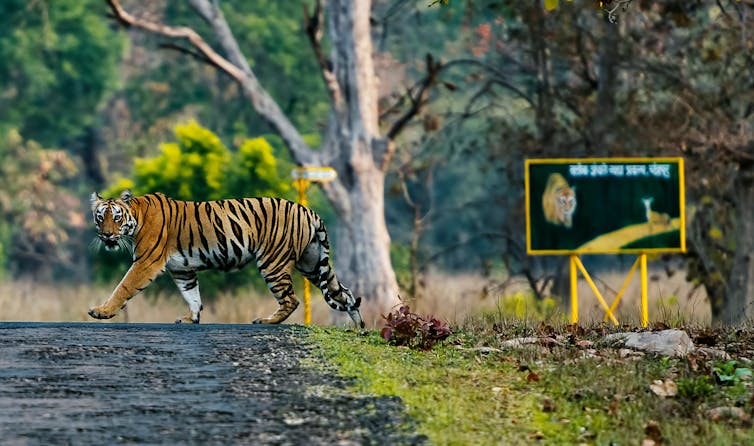The year 2023 coincided with the 50th anniversary of India’s groundbreaking Project Tiger, an innovative programme designed to rescue the country’s iconic big cat from the precipice of extinction. In April, as part of these celebrations, prime minister Narendra Modi announced that tiger numbers in India have now surpassed 3,000, representing more than 70% of the wild tigers in the world.
From an initial investment in 1973 of just nine dedicated tiger reserves, India now protects 54 such areas. It adds up to an area in excess of 75,000 sq kilometres, or about 2% of the country.
Now, new research in the journal Nature Ecology and Evolution has identified a link between tiger conservation and the fight against climate change. Tigers are very adaptable and the exact same subspecies, the Bengal tiger, can be found scattered across India in jungles, mangroves and so-called “dry forests”. These habitats might seem very different, but the common link is of course lots of trees.
According to the authors of the new study, the strict protection provided within India’s network of tiger reserves has avoided huge amounts of deforestation. And by preserving forests that would have otherwise been chopped down, between 2007 and 2020, tiger protection may have contributed to over 1 million tonnes of avoided carbon emissions.
A million tonnes of carbon might sound like a lot, though it won’t put a huge dent in climate change. India alone emits about 2.7 billion tonnes each year (albeit very little per capita). But that isn’t the point.
India’s tiger reserves are spread across most of the country. India National Tiger Conservation Authority, CC BY-SA
In a monetary sense, that avoided deforestation and saved carbon can be equated to US$6.24 million (£5.06 million) in direct carbon offsets and, if wider “ecosystem services” such as watershed management and the provision of fuel and firewood are considered, this figure could rise to as much as US$92 million (£75m). The authors of the new research suggest that this could be a gamechanger for tiger protection, as it could be funded through carbon offset schemes.
There are critics who view India expanding its tiger reserves as an economic extravagance, one that brings the animals into conflict with humans and criminalises local communities (some of whom have been moved out of reserves) for living as they have always done. But in a neoliberal world where everything has a price tag, the future of vulnerable wildlife often depends on its ability to justify its own survival. And if carbon storage can be added to the list of reasons to protect tiger habitat, this in turn may provide fresh impetus for conservation.
Strolling into Tadoba reserve in central India. RealityImages / shutterstock
Still lots of habitat left
Even after centuries of deforestation and an expansion of farmland to feed a billion people, there still seems to be land available. In a recent interview in The Hindu newspaper the prominent tiger biologist Ullas Karanth made it clear that India has the potential, on paper at least, to quadruple its wild tiger numbers over the longer term. According to Karanth, there is still an estimated 380,000 sq kilometres of potential habitat available, just 20% of which is currently under strict protection and containing tigers.
Pilibhit Tiger Reserve along the border with Nepal, one of 54 reserves in India. Sourabh Bharti / shutterstock
The loss of their forests is still the main reason why tigers are threatened. But this meant there are habitats available that have been emptied of tigers by hunting, and which cannot be colonised by new populations since there are no safe “wildlife corridors” connecting one patch of forest to another.
If these vacant forests were given their proper value and managed with both (reintroduced) big cats and the climate in mind, India could further cement its position as the world leader in tiger conservation. Eventually it could start exporting surplus tigers to repopulate sites in neighbouring countries where Bengal tigers have declined (the many tigers in captivity, especially in the US, are too used to humans to be released into the wild).
This is a win-win situation. It would also help India to re-establish its green credentials during an era in which the country’s emphasis on development and business has conflicted with parallel efforts to protect its natural environment.



 Ethereum Bulls Reload: $175M ETF Inflows + Super-Whale Grabs $54M ETH as Price Coils for the Next Big Move
Ethereum Bulls Reload: $175M ETF Inflows + Super-Whale Grabs $54M ETH as Price Coils for the Next Big Move  European Luxury Market Set for a Strong Rebound in 2026, UBS Says
European Luxury Market Set for a Strong Rebound in 2026, UBS Says  EUR/USD Smashes 1.1660 as ADP Jobs Massacre Crushes the Dollar
EUR/USD Smashes 1.1660 as ADP Jobs Massacre Crushes the Dollar  China Vanke Hit with Fresh S&P Downgrade as Debt Concerns Intensify
China Vanke Hit with Fresh S&P Downgrade as Debt Concerns Intensify  Bitcoin Defies Gravity Above $93K Despite Missing Retail FOMO – ETF Inflows Return & Whales Accumulate: Buy the Dip to $100K
Bitcoin Defies Gravity Above $93K Despite Missing Retail FOMO – ETF Inflows Return & Whales Accumulate: Buy the Dip to $100K  India’s IT Sector Faces Sharp 2025 Valuation Reset as Mid-Caps Outshine Large Players
India’s IT Sector Faces Sharp 2025 Valuation Reset as Mid-Caps Outshine Large Players  U.S. Black Friday Online Spending Surges to $8.6 Billion, Boosted by Mobile Shoppers
U.S. Black Friday Online Spending Surges to $8.6 Billion, Boosted by Mobile Shoppers  Morgan Stanley Boosts Nvidia and Broadcom Targets as AI Demand Surges
Morgan Stanley Boosts Nvidia and Broadcom Targets as AI Demand Surges 
































